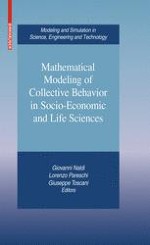2010 | OriginalPaper | Chapter
New perspectives in the equilibrium statistical mechanics approach to social and economic sciences
Authors : Elena Agliari, Adriano Barra, Raffaella Burioni, Pierluigi Contucci
Published in: Mathematical Modeling of Collective Behavior in Socio-Economic and Life Sciences
Publisher: Birkhäuser Boston
Activate our intelligent search to find suitable subject content or patents.
Select sections of text to find matching patents with Artificial Intelligence. powered by
Select sections of text to find additional relevant content using AI-assisted search. powered by
In this chapter we review some recent development in the mathematical modeling of quantitative sociology by means of statistical mechanics. After a short pedagogical introduction to static and dynamic properties of many body systems, we develop a theory for particle (agents) interactions on random graph.
Our approach is based on describing a social network as a graph whose nodes represent agents and links between two of them stand for a reciprocal interaction. Each agent has to choose among a dichotomic option (i.e., agree or disagree) with respect to a given matter and he is driven by external influences (as media) and peer to peer interactions. These mimic the imitative behavior of the collectivity and may possibly be zero if the two nodes are disconnected.
For this scenario we work out both the dynamics and, given the validity of the detailed balance, the corresponding equilibria (statics). Once the two-body theory is completely explored, we analyze, on the same random graph, a
diffusive strategic dynamics
with pairwise interactions, where detailed balance constraint is relaxed. The dynamic encodes some relevant processes which are expected to play a crucial role in the approach to equilibrium in social systems, i.e., diffusion of information and strategic choices. We observe numerically that such a dynamics reaches a well defined steady state that fulfills a
shift
property: the critical interaction strength for the canonical phase transition is higher with respect to the expected equilibrium one previously obtained with detailed balanced dynamical evolution.
Finally, we show how the stationary states of this kind of dynamics can be described by statistical mechanics equilibria of a diluted p-spin model, for a suitable noninteger real
p
>2. Several implications from a sociological perspective are discussed together with some general outlooks.
